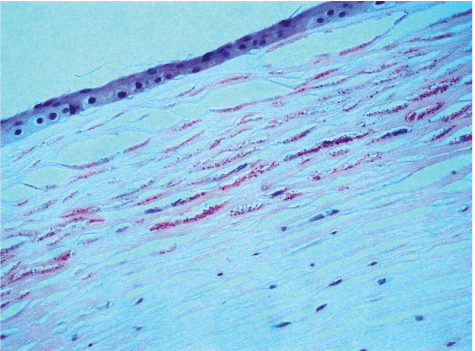IMAGE ARTICLE | VOLUME 3, ISSUE 1 | OPEN ACCESS DOI: 10.23937/2474-3682/1510058
Microsporidia Stromal Keratitis
Sarah Farukhi Ahmed1 , Donald Minckler2 and Hans E Grossniklaus3
1Ophthalmology Resident, University of California in Irvine, USA
2Director of Ophthalmic Pathology, University of California Irvine, USA
3Director, L.F. Montgomery Pathology Laboratory, USA
*Corresponding author:
Sarah Farukhi Ahmed, Ophthalmology Resident, University of California in Irvine, USA, E-mail: sfarukhi@uci.edu
Received: July 01, 2016 | Accepted: April 15, 2017 | Published: April 17, 2017
Citation: Ahmed SF, Minckler D, Grossniklaus HE (2017) Microsporidia Stromal Keratitis. Clin Med Img Lib 3:058. doi.org/10.23937/2474-3682/1510058
Copyright: © 2017 Ahmed SF, et al. This is an open-access article distributed under the terms of the Creative Commons Attribution License, which permits unrestricted use, distribution, and reproduction in any medium, provided the original author and source are credited.
Background
Microsporidia Stromal Keratitis presents more commonly in immune competent patients. Risk factors include contact lens wear, trauma or travel to Southeast Asian countries with exposure to contaminated water. Patients present unilateral progressive eye redness, vision loss and pain. This presentation is often misdiagnosed as herpes simplex virus, so a corneal scraping or biopsy should be performed to confirm the diagnosis [1-5].
References
-
Benson CA, Kaplan JE, Masur H, Pau A, Holmes KK, et al. (2004) Treating opportunistic infections among HIV-infected adults and adolescents: recommendations from CDC, the National Institutes of Health, and the HIV Medicine Association/Infectious Diseases Society of America. MMWR Recomm Rep 53: 1-112.
-
Khandelwal SS, Woodward MA, Hall T, Grossniklaus HE, Stulting RD (2012) Treatment of microsporidia keratitis with topical voriconazole monotherapy. Arch Ophthalmol 129: 509-510.
-
Peter R (2015) Microsporidiosis. Uptodate.
-
Weller Peter (2015) Fumagillin. Uptodate.
-
Davis RM, Font RL, Keisler MS, Shadduck JA (1990) Corneal microsporidiosis. A case report including ultrastructural observations. Ophthalmology 97: 953-937.

